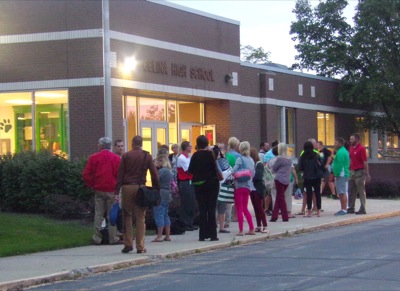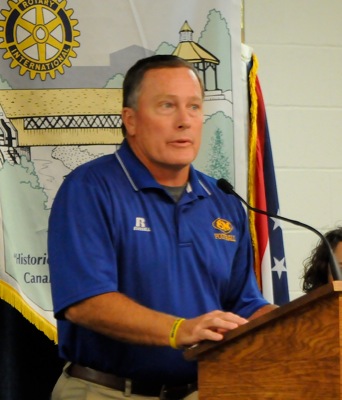Thursday, August 27th, 2015
Fort Recovery seeks to create blueprint for village growth
By William Kincaid
FORT RECOVERY - For the village to grow, officials must create a blueprint to foster residential and commercial expansion, business and industrial leaders concluded on Wednesday night.
More than 40 stakeholders convened in the Jerome and Maurice Grieshop Athletic Training Facility at the high school to help create a plan for long-term growth. The effort is being spearheaded by village officials, architect Paul Sullivan and Project Recovery, a nonprofit organization that spearheaded the downtown revitalization two decades ago.
"Areas of growth that people thought were important, in this order, were residential, commercial and industrial. They think residential is the most important growth area that we have in the community and we don't disagree with that," village administrator Randy Diller said about the results of a community survey.
Fort Recovery is essentially landlocked - to the north and south are industrial-zoned parks, in the center is the downtown business district surrounded by residential areas. Growth will require modifying zoning and acquiring land to the east and west of the village.
It's difficult to attract new professionals like a dentist to town when no homes or lots are available, one attendee opined.
"Trying to accommodate those people and keep the young people here - because you can't grow businesses if you don't have people - so whatever it takes, we've got to get more places because there's no place to build," one man said. "Because I think there's a lot of young people who want to stay here ... they have to have someplace to go. We've got good people. Good kids are going to have good families just like we have. Let's not chase them out."
Another attendee said some people end up living in other nearby towns because Fort Recovery lacks housing. Once those people plant roots, they likely won't move.
Discussion also focused on augmenting the downtown business district.
"I think we all know businesses that could have expanded if there was room and they're saying there isn't room," Lori Kaup said about the business district. "We wanted (Dollar General) to be downtown and they said there was no room for it to be downtown."
One idea is to expand the business district toward the Wabash River on Wayne Street, Kaup said.
"Could we take some of those homes and turn them into restaurants or a place for an attorney, maybe a dentist office, could we go that way with that?" she asked. "And it doesn't have to be tomorrow we're going to go buy all those homes. It just has to be a plan that we could go that way if we wanted to."
Joe Faller asked if a new commercial district could be created, perhaps centered on professionals, such as lawyers.
"Segment the downtown being retail or close to that and the professional-type buildings - the accountants and medical people and so on - in another area," Faller said.
Sullivan opposed that idea, saying consolidation is the way to get the "biggest bang for your bucks." One of the village's key attributes is its "walkability," as people can do most of their shopping in a central area.
Greg LeFevre addressed the village's business climate, emphasizing the need for skilled workers.
"There's 50 or 60 maintenance jobs available in Mercer County and I know that we're (JR Manufacturing) always looking for maintenance guys and it comes down to skilled labor," he said. "We've got engineer spots open and different things like that. ... We just haven't found anybody that we felt was capable yet."
Other concerns included the prospect of a mechanical wastewater treatment system and the escalation of flooding in recent years due to development.
One attendee said an industrial-certified wastewater treatment system is needed to maintain or grow the industrial sector.
Diller acknowledged that it's very expensive for some businesses to conduct in-house pretreatment now with the village's lagoon system. Officials have looked into options but it's hard to justify doubling resident's utility bills to pay for a mechanical system.
"Obviously the concern is, from a town the size of 1,430 people, their bills are going to go up dramatically, dramatically to operate a mechanical plant and treat all that as opposed to operating a lagoon system like we do now," Diller said.
As far as flooding, Diller said this summer has seen unusually heavy rains.
"Everybody wants growth, and whether it be residential, be industrial, commercial, whatever, it all creates additional surface water," Diller said.
The information gathered from the public meetings - this was the third - and surveys will be used to create a long-term plan to be presented to the community.
Surveys can still be filled out online on the village's website.


